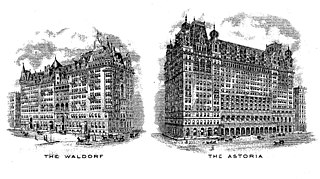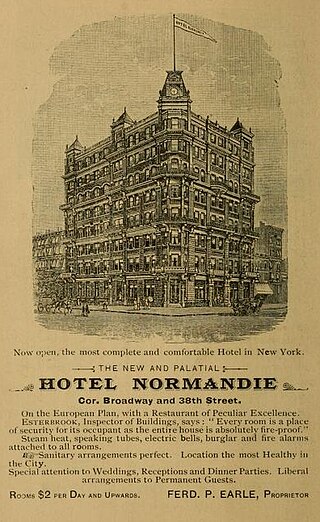
The Grand Central Hotel, later renamed the Broadway Central Hotel, was a hotel at 673 Broadway, New York City, that was famous as the site of the murder of financier James Fisk in 1872 by Edward S. Stokes.

The Beach Pneumatic Transit was the first attempt to build an underground public transit system in New York City. It was developed by Alfred Ely Beach in 1869 as a demonstration subway line running on pneumatic power. The line had one stop in the basement of the Rogers Peet Building, near the old City Hall station, and a one-car shuttle running between the building and a dead end approximately 300 feet (91 m) away. It was not a regular mode of transportation and lasted from 1870 until 1873.

The Astor House was a luxury hotel in New York City. Located on the corner of Broadway and Vesey Street in what is now the Civic Center and Tribeca neighborhoods of Lower Manhattan, it opened in 1836 and soon became the best-known hotel in America. Part of it was demolished in 1913; the rest was demolished in 1926.
Jonathan Leavitt was a bookbinder who later co-founded the New York City publishing firm of Leavitt & Trow, one of the nation's first publishing houses. Leavitt was also co-founder of another early New York publishing house with his brother-in-law Daniel Appleton. George Palmer Putnam, who went on to found a New York publishing dynasty, received his first job from Leavitt. Eventually Jonathan Leavitt went into business on his own, and after his death the firm was run by his son George Ayres Leavitt.

The Hotel St. Moritz was a luxury hotel located at 50 Central Park South, on the east side of Sixth Avenue, in Midtown Manhattan, New York City. The structure was extensively rebuilt from 1999 to 2002, and today it is a hotel/condominium combination known as The Ritz-Carlton New York, Central Park.

Gilsey House is an eight-story, 300-room former hotel at 1200 Broadway at West 29th Street in the NoMad neighborhood of Manhattan, New York City. It is a New York City landmark and on the National Register of Historic Places.

The Pabst Hotel occupied the north side of 42nd Street in Manhattan, New York City, between 7th Avenue and Broadway, in Longacre Square, from 1899 to 1902. It was demolished to make room for the new headquarters of The New York Times, for which Longacre Square was renamed Times Square.

The Martinique New York on Broadway, Curio Collection by Hilton is a 532-room hotel at 53 West 32nd Street in Manhattan, New York City. It was designed by Henry Janeway Hardenbergh and built by William R. H. Martin, who headed the Rogers Peet business, in a French Renaissance style. The Martinique was developed in three sections between 1897 and 1911. The hotel is a New York City designated landmark and is part of the Historic Hotels of America.

The Waldorf-Astoria originated as two hotels, built side by side by feuding relatives, on Fifth Avenue in New York, New York, United States. Built in 1893 and expanded in 1897, the hotels were razed in 1929 to make way for construction of the Empire State Building. Their successor, the current Waldorf Astoria New York, was built on Park Avenue in 1931.

Archer & Pancoast Manufacturing Company was a US gas fixtures manufacturing company. It was located at No. 67 Greene Street, and Nos. 68 to 74 Wooster Street, in New York City, New York. Archer & Pancoast Manufacturing Company manufactured fixtures for gas and electric lights -- separately for gas or electricity, or combined for both. The fixtures were found in the residences of the Vanderbilts and Marquands of New York, as well as Potter Palmer's of Chicago. They also equipped Madison Square Garden, Manhattan Athletic Club, Equitable Life, and United States Trust. In San Francisco, their work appeared in the Palace Hotel; in Indianapolis, in the Indiana State Capitol; and in Hartford, in the Connecticut State Capitol.

The St. Nicholas Hotel was a 600-room, mid-nineteenth century luxury hotel on Broadway in the neighborhood of SoHo in Manhattan, New York City. It opened on January 6, 1853, and by the end of the year had expanded to 1,000 rooms. The St. Nicholas raised the bar for a new standard of lavish appointments for a luxury hotel. It was the first New York City building to cost over US$1 million. The hotel was said to have ended the Astor House's preeminence in New York hostelry.

Murray Hill Hotel was a hotel situated at 112 Park Avenue in Murray Hill, Manhattan, New York City. Built in 1884, with 600 rooms and two courtyards, it was demolished in 1947. It was part of the Bowman-Biltmore Hotels chain.

Hamilton Hotel was the first hotel in Bermuda. Located on Church Street in Hamilton, construction began in 1852 and opened its doors in 1861. The hotel was instrumental in starting tourism in Bermuda. It was destroyed by fire in 1955.

Harlem Opera House was an opera house located at 211 West 125th Street, in the Harlem neighborhood of Manhattan in New York City, New York, U.S. Designed by architect John B. McElfatrick, it was built in 1889 by Oscar Hammerstein; it was his first theater in the city.

Holland House was a New York City hotel located at 274–276 Fifth Avenue at the southwest corner of 30th Street in NoMad, Manhattan, New York City, with a frontage of 250 feet (76 m) on Fifth Avenue. The architects and designers were George Edward Harding & Gooch. A mercantile building by the 1920s, in the present day, it is a loft building.

Fowler & Wells Company was a 19th-century American publishing house, based in New York City. The business was classified as phrenologists and publishers, but it was also a scientific and educational institution. The company was established in 1835 by the brothers Orson Squire Fowler and Lorenzo Niles Fowler. Samuel Roberts Wells joined the company in 1843, and he subsequently married Charlotte Fowler, a sister of the Fowler brothers. Eventually, the Fowler brothers left the company, and Samuel Wells died. In 1884, Charlotte Fowler incorporated the company and became its president.
National Household Economic Association (1893-1903) was a 19th-century American women's organization which promoted the new field of home economics.

The Trinity Building, designed by Francis H. Kimball and built in 1905, with an addition of 1907, and Kimball's United States Realty Building of 1907, located respectively at 111 and 115 Broadway in Manhattan's Financial District, are among the first Gothic-inspired skyscrapers in New York, and both are New York City designated landmarks. The Trinity Building, adjacent to the churchyard of Richard Upjohn's neo-Gothic Trinity Church, replaced an 1853 Upjohn structure of the same name. Earlier, the Van Cortlandt sugar house stood on the west end of the plot – a notorious British prison where American soldiers were held during the Revolutionary War.

The City Hotel (1794–1849) stood at 123 Broadway, occupying the whole block bounded by Cedar, Temple, and Thames Streets, in today's Financial District of Manhattan, New York City. It was the first functioning hotel in the United States. Until the early 1840s it was the city's principal site for prestigious social functions and concerts. Designed by John McComb Jr., it offered not only luxurious accommodations, but also such amenities as shops, a barroom, and a coffeehouse, as well as public dining and dancing. Its five stories and 137 rooms replaced the former home of Stephen Delancey, built around 1700, which had become an inn.

The Hotel Normandie was a luxury hotel located on Broadway at 38th Street in New York City. The 8-story building was put up by Ferdinand Earl, an heir of the Fisher family, opening in 1884. Amenities were advertised to include "Steam heat, speaking tubes, electric bells, burglar and fire alarms attached to all rooms". Rooms rates started at $2/day. Dinner was available for $1.25 additional; a quart bottle of Moët & Chandon champagne was $4.




















